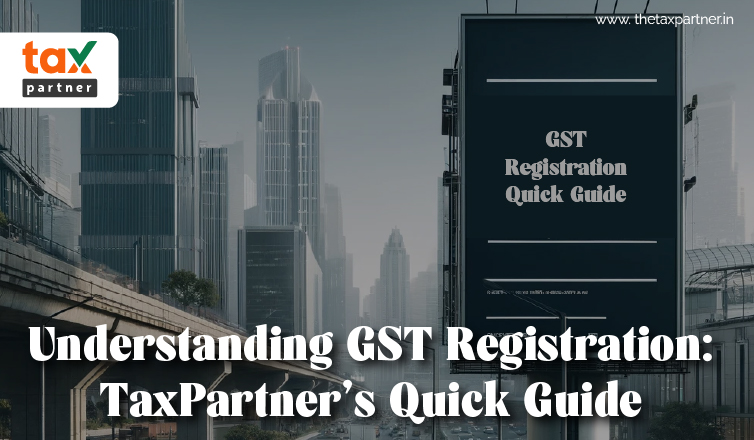Understanding GST Registration
Understanding GST Registration: TaxPartner’s Quick Guide
Author-Tanvi Thapliyal
The introduction of the Goods and Services Tax (GST) in India is a significant milestone in the country's tax history. The GST was designed to simplify the complicated tax system that existed before it was implemented. It is a major step towards creating a more unified and transparent tax system. The goal of GST is to simplify taxation procedures, reduce tax evasion, and create a better environment for economic growth by combining different indirect taxes into one comprehensive framework.
GST registration is essential for businesses looking for assistance with India's complex tax system. Not only does it symbolise a legal obligation, but it also acts as a way for businesses to become part of the official economy. By registering for GST, businesses are able to adhere to the tax laws of the country, which helps them stay in line with regulations and support the overall economic system. Moreover, registering for GST makes it easier for businesses to engage in interstate trade, allowing them to grow their customer base and take advantage of new market prospects.
In this article, we will discuss the details of GST registration in India, including its importance, the steps involved, and the advantages it provides to businesses. We want to help businesses understand the significance of GST registration so that they can effectively handle India's tax system and succeed in the changing economy. Our goal is to provide businesses with the information and tools they need to navigate the complexities of the tax regime.
The background of GST implementation
The process of implementing the Goods and Services Tax (GST) in India has involved a lot of discussions, difficulties, and important achievements. Before the introduction of GST, India had a tax system that involved many indirect taxes imposed by both the central and state governments. The tax structure was fragmented, which meant that taxes were piled on top of each other. This resulted in higher costs for businesses and made it difficult for interstate commerce to flow smoothly.
The concept of GST was initially suggested by the government of Atal Bihari Vajpayee in 2000. They acknowledged the necessity of streamlining India's tax system and establishing a single market. But, turning this vision into a reality was a difficult and challenging undertaking. The main challenges we faced were getting everyone to agree, dealing with the concerns of state governments about losing revenue, and creating a GST model that works well with India's federal system.
The enactment of the Constitution (One Hundred and First Amendment) Act, 2016 was a major step in the process of implementing GST. The constitutional amendment gave both the central and state governments the power to levy and collect GST, which formed the basis for the GST regime. The GST Council was established to make decision-making on GST rates, exemptions, and administrative matters easier. It includes representatives from both the central and state governments.
India officially adopted the GST regime on July 1, 2017, which replaced several indirect taxes with a single tax system. According to the GST regime, different rates of tax are applied to goods and services - 0%, 5%, 12%, 18%, and 28%. Some goods may also have an additional cess. The transition had a big impact on businesses. They had to make changes like reorganising their supply chains, upgrading their IT systems, and adjusting to new compliance requirements.
The impact of GST on businesses and the economy has been varied and complex. The implementation of GST aimed to simplify taxation and create a unified market. However, businesses initially faced challenges in adapting to new compliance procedures and technology requirements. Over time, the Goods and Services Tax (GST) has made it easier to do business by getting rid of the problem of taxes piling up, making it less burdensome to follow regulations, and encouraging smooth trade between states.
Overall, the introduction of GST in India is a significant move that aims to establish a tax system that is both more effective and transparent. Although there were difficulties during the transition period, GST has proven to be a driving force for economic growth. It has created favourable conditions for businesses to flourish and seize new opportunities.
Steps to register for GST in India
-
To determine your eligibility for GST registration, you need to check if your business meets the criteria for registration. Usually, if a business makes more money than the specified threshold in a year, they have to sign up for GST.
-
make sure that you are eligible.
-
gather all the necessary documents:
-
The business's Permanent Account Number (PAN)
-
identity and address proofs of the proprietor, partners, or directors.
-
proof of your business registration, such as an incorporation certificate or partnership deed.
-
bank account details
-
photographs
-
proof of address for the place of business, such as a rental agreement or electricity bill.
-
Create an account on the GST Portal
-
You can visit the official GST portal at https://www.gst.gov.in/ to create an account.
-
Make sure to use a valid email address and mobile number during the registration process. Please submit Form GST REG-01.
-
Once you have successfully created an account on the GST portal,
-
you can log in and go to the 'Services' tab.
-
From there, you can select the 'Registration' option and then choose 'New Registration' to proceed. On this page, you can access Form GST REG-01, which is the application form for GST registration.
-
provide the necessary details on Form GST REG-01, including the name of your business, address, and type of entity.
-
upload the documents that you have collected in step 2.
-
After you submit the application, you will receive an SMS and verification email on the email address and mobile number that you registered.
-
Verify the application digitally by using the Electronic Verification Code (EVC), Digital Signature Certificate (DSC), or E-signature that has been sent to your registered mobile number.
-
Once you submit your application, it will be verified by the GST officer. You can request additional information or documents at this stage if needed.
-
If your application for a GST certificate is accurate and complete, and the verification process goes smoothly, you can expect to receive your GST certificate within a few days.
-
The GST certificate includes the Goods and Services Tax Identification Number (GSTIN), which acts as your unique identification number for GST compliance.
-
Make sure to display your GSTIN at your business premises once you receive the GST certificate. It should be prominently visible.
-
After you have registered, you will need to regularly submit GST returns. These include GSTR-1 for outward supplies, GSTR-3B for a summary return, and any other applicable returns based on your business activities.
-
make sure to follow all GST regulations, which include filing your returns on time, paying your taxes, and following all GST laws and regulations.
-
Make sure to keep your GST registration information up to date by informing the authorities about any changes to your business address, partners, directors, or structure.
-
If your business stops operating or no longer meets the requirements for GST registration, you should apply to cancel your registration to avoid any issues with non-compliance.
Benefits of GST registration
-
Registering for GST gives businesses legitimacy and helps them comply with the tax laws of the country.
-
When a business operates within the formal economy, it helps build trust and confidence among stakeholders and customers, making the business more credible.
-
Input Tax Credit (ITC): One of the great advantages of registering for GST is that you can claim input tax credit. Businesses have the ability to balance out the GST they paid on purchases of goods and services by deducting it from the GST they collected on sales of goods and services. By reducing production costs and overall tax liability, it helps to increase profitability. Let's say a manufacturing company buys raw materials. They can claim input tax credit on the GST they paid for those materials, which helps lower the cost of production.
-
GST registration allows businesses to expand their market reach by engaging in interstate commerce without any restrictions. Businesses can expand their customer base across state lines by getting rid of obstacles like cascading taxes and different tax structures in different states. By doing this, they are able to explore and take advantage of new markets and opportunities for expansion. For example, a textile manufacturer that is registered under GST can easily sell its products to customers in different states without facing any tax-related obstacles.
-
Access to E-commerce Platforms: In order to sell on many e-commerce platforms, sellers are usually required to be registered under GST. Registering for GST allows businesses to utilise these platforms, which helps them reach a larger audience and take advantage of the expanding e-commerce industry. Take, for instance, an artisan who sells handmade crafts. They can choose to register for GST in order to sell their products on well-known e-commerce platforms. This way, they can enhance their visibility and increase their chances of making more sales.
Challenges Faced in GST Registration:
-
The complexity of registration procedures is one of the main challenges that businesses face during the GST registration process.
-
Businesses, especially small and medium-sized enterprises (SMEs) with limited resources and expertise in tax compliance, often find the extensive documentation requirements and complicated registration forms to be overwhelming.
-
There are some technical issues with the GST Portal that businesses sometimes encounter. These issues can include glitches and system downtime, which can make it difficult for businesses to register for GST through the portal. When the loading times are slow, errors occur during form submission, and it's difficult to access necessary information, it can really slow down the registration process and make applicants frustrated.
-
It can take quite some time to verify the documents that are submitted during the GST registration process. This can cause delays in receiving the GST certificate. Businesses might have to wait for a long time for document verification by GST authorities, which can affect their ability to operate legally and claim input tax credit.
-
Companies that operate in multiple states have to deal with extra complications when it comes to interstate registration. Every state has its own GST authorities and registration procedures. This means that businesses have to deal with multiple regulatory frameworks and follow different compliance requirements. Businesses that operate across different jurisdictions in India often face significant challenges when it comes to coordinating and aligning their registration processes.
-
After registering, businesses have to follow several GST compliance requirements. This includes filing returns on time, paying taxes, and keeping accurate records.
-
Dealing with GST can be really overwhelming, especially for small businesses that don't have a lot of money or resources for managing all the paperwork and administrative tasks.
-
It can be difficult to figure out the right business classification under GST, especially for businesses that have complicated organisational structures or operate in multiple industries. If you misclassify your business activities, it can cause mistakes in your tax reporting and compliance. This could lead to penalties or legal consequences.
Conclusion
Getting registered for GST is a very important requirement for businesses in India. It helps them comply with tax regulations and become a part of the formal economy. In this article, we have discussed the importance of GST registration, the difficulties that businesses encounter when registering, and the potential advantages of overcoming these obstacles.
Businesses need to register for GST in order to operate legally and be part of the official economy. Ensuring compliance with tax laws not only helps businesses follow the rules, but also makes them more credible and trustworthy in the eyes of stakeholders and customers. When businesses register for GST, they can take advantage of input tax credit. This helps them lower their production costs and overall tax liability, which ultimately boosts their profitability.
Businesses often face challenges like procedural complexities, technical issues, and compliance burdens when going through the GST registration process. However, if these challenges are overcome, there can be many benefits to be gained. When you successfully register for GST, it makes the process of paying taxes simpler, helps with running a business smoothly, and ensures that you are following all the necessary tax rules and regulations. Businesses have the opportunity to make their operations more efficient, reach a wider market, and use online platforms to grow, which can contribute to economic development and prosperity.
Moreover, registering for GST promotes transparency, accountability, and fairness in the tax system, which ultimately leads to a more efficient and fair business environment. Businesses can position themselves for long-term success and contribute to India's journey towards economic growth and development by embracing GST registration and navigating through its challenges.
Basically, getting registered for GST is not only something that businesses are legally required to do, but it also presents them with a chance to succeed in a competitive marketplace. Understanding the importance of GST registration, overcoming challenges, and reaping its benefits can help businesses unlock their full potential and establish themselves as key players in India's dynamic business landscape.
FAQ’S
Who needs to register for GST in India?
Any business whose turnover exceeds the prescribed threshold or engages in specific economic activities as defined by the GST law must register for GST.
What is the turnover threshold for GST registration?
The turnover threshold for GST registration varies based on the type of business. For most businesses, the threshold is ₹40 lakhs for goods suppliers and ₹20 lakhs for service providers.
How do I determine if my business is eligible for GST registration?
You can determine your eligibility for GST registration by assessing whether your business's annual turnover exceeds the prescribed threshold or if it engages in activities specified under the GST law.
What documents are required for GST registration?
The documents required for GST registration include PAN of the business, identity and address proofs of the proprietor/partners/directors, proof of business registration, bank account details, photographs, and address proof of the place of business.
How do I apply for GST registration?
You can apply for GST registration online through the official GST portal (https://www.gst.gov.in/) by filling out Form GST REG-01 and uploading the necessary documents.
Is there a fee for GST registration?
No, there is no fee for GST registration. It is free of charge.
How long does it take to get GST registration after applying?
The processing time for GST registration typically ranges from 3 to 7 working days, provided that all required documents are submitted accurately.
Do I need to register separately for each state if my business operates in multiple states?
Yes, if your business operates in multiple states, you need to obtain separate GST registration for each state where your business has a presence.
What is the validity period of GST registration?
GST registration is valid indefinitely unless cancelled or surrendered. However, certain taxpayers are required to renew their registration periodically.
Can I apply for GST registration voluntarily even if my turnover is below the threshold?
Yes, you can voluntarily register for GST even if your turnover is below the threshold. This is beneficial for businesses looking to avail input tax credit or expand their market reach.
What is the penalty for not registering for GST when required?
The penalty for not registering for GST when required can be substantial. It may include a penalty of up to 10% of the tax due or ₹10,000, whichever is higher.
Do I need to file GST returns if my turnover is below the threshold after registration?
Yes, once registered for GST, businesses are required to file GST returns even if their turnover falls below the threshold. Compliance with GST regulations is mandatory for all registered taxpayers.
Can I cancel my GST registration?
Yes, GST registration can be cancelled if your business ceases operations, or if it no longer meets the criteria for registration. You can apply for cancellation of registration through the GST portal.
What is the consequence of not updating my GST registration information?
Failure to update GST registration information may result in penalties or legal repercussions. It's important to keep your registration details up-to-date to avoid non-compliance issues.
Can I transfer my GST registration to another person or entity?
No, GST registration is not transferable. If there is a change in ownership or structure of the business, the new entity must apply for fresh GST registration.



